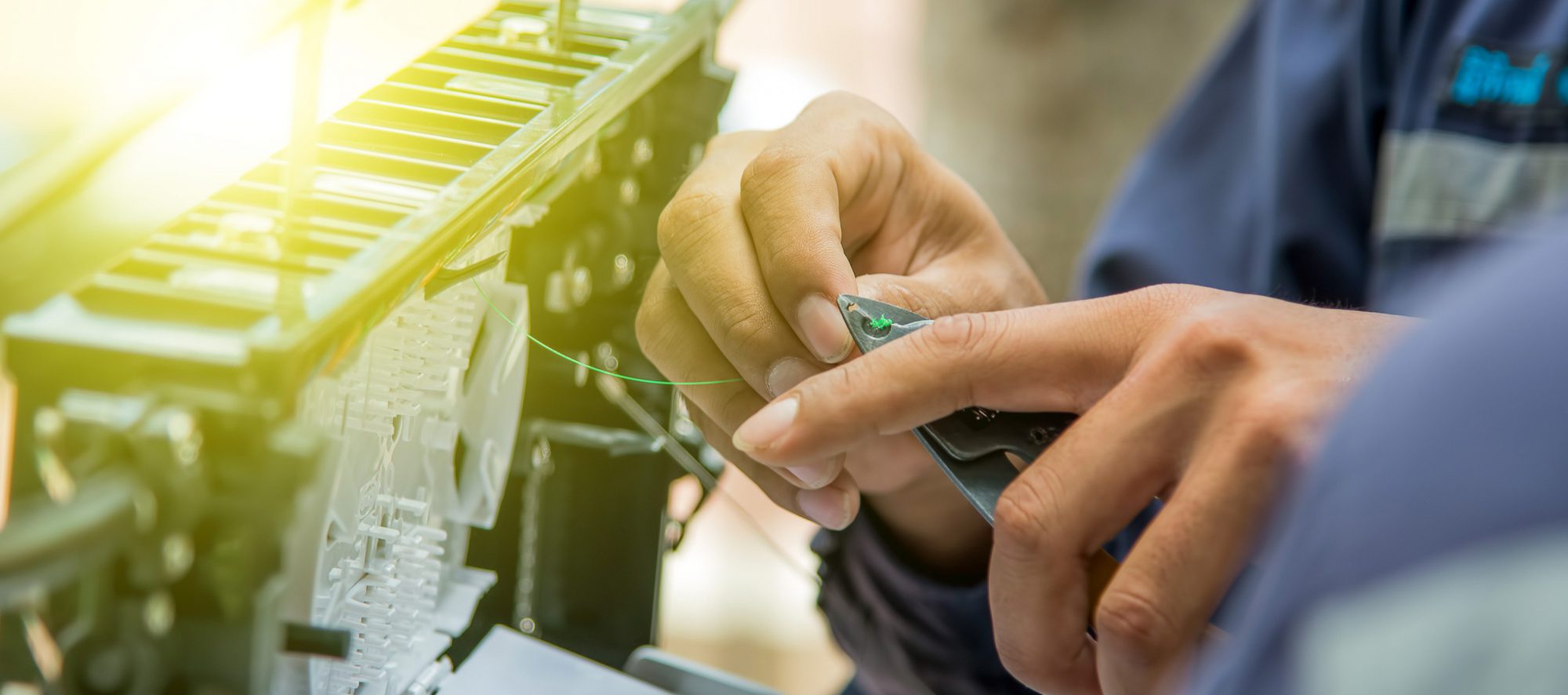
| Exam Fees Included in Tuition! | This course is sanctioned by the Fiber Optic Association (FOA), the largest professional society of fiber optics in the world. FOA courses offered by BDI DataLynk are recognized by The US Department of Labor. |
Course Description:
Looking to jumpstart your career? Take our Fiber Optics Bootcamp!
This program is an intensive, accelerated version of our traditional Fiber Optic training program, equipping you with 3 Fiber Optic Association sanctioned Certifications in 5 Days. No prior experience necessary. This five-day boot camp includes our foundational three certified fiber optic courses–Certified Fiber Optics Technician, Certified Fiber Optics Specialist/Splicing, and Certified Fiber Optics Specialist/Testing & Maintenance. Cost includes study materials, exam fees and textbooks for all three courses.
Certified Fiber Optic Technician: This introductory fiber optic tech course is designed for anyone interested in becoming a Certified Fiber Optic Technician and is a pre-requisite for any of the specialist Certifications. This Fiber Optic Training combines theory and 85% hands-on activities to prepare the student to take the CFOT (Certified Fiber Optic Technician) test that is sanctioned by the FOA (Fiber Optics Association) and given and graded the final class day. This course also introduces the student to industry standards governing FTTD (Fiber To The Desk), FTTH (Fiber To The Home), and Distribution Cabling. Students will learn how to identify fiber types, recognize various connectors used in fiber installation; and install, terminate, splice, and properly test installed fiber cable to existing standards.
Certified Fiber Optic Specialist in Testing: This program is designed to offer advanced training to anyone involved with the testing and maintenance of fiber optics networks. A focal point in the program is to offer a general, easy to understand, approach to fiber optics testing standards with little theory and considerable hands on activities. This comprehensive program explains the variety of testing standards, equipment and technological approaches used in fiber network testing and splicing and how to choose among them. This 85% hands on course explores the overall spectrum of testing and maintenance of singlemode fiber optics networks and provides a detailed overview and demonstration of various pieces of equipment used in testing and maintenance. Subject matter includes a detailed study of ANSI/TIA/EIA-526-(7)A, OTDR fundamentals and uses, OTDR vs. Insertion Loss Testing, Return Loss Testing, and Attenuation testing using the Power Source and Light Meter.
Certified Fiber Optic Specialist in Splicing: This Splicing Specialist Training includes a complete PowerPoint presentation explaining the importance of high performance splicing and further details the points necessary to achieve these splices. The depth of this presentation is much greater than most textbooks and provides background information about splicing that is very important to the student. An overview of OTDR functions and trace understanding is also provided during this presentation. 85% hands-on classroom activities will provide training in both fusion and mechanical splicing of either single or multimode fiber optic cables. Inside or outside plant fiber optic cable types will be utilized at instructor’s discretion during these hands-on sessions along with fiber optics enclosures and splice trays. The student will be responsible for successfully making and testing both mechanical and fusion splices. In addition to the basic splicing activities outlined above, the student will further be required to correctly and efficiently install spliced fibers into splice trays and enclosures. The student will further be required to achieve a splice loss of less than 0.15 dB for all splices and demonstrate proficiency in interpretation of splice loss using OTDR splice traces.
The student must pass both the written and hands on exams to successfully pass this course. Course fee includes all books study materials, exams and 3-year membership to the FOA.
Note: Actual number of hours may vary depending on number of students.
Course Objective:
Program prepares the student to take the CFOT, CFOST, and CFOSS exams given and graded during the boot camp. Student will be
able to effectively and efficiently install, terminate, and test multimode fiber optic networks to existing standards.
Prerequisite:
Able to see, identify and manipulate small items and be able to read and speak the English language.
METHOD OF ASSESSING WHETHER COURSE OBJECTIVE WAS MET:
Along with chapter tests, class discussions, and substantial hands-on activities, the FOA exams are given and graded during the class. Students will demonstrate the ability to build and test and troubleshoot a fiber optic LAN network.
Program prepares the student to take the Specialist in Testing & Maintenance Fiber Optics Certification Exam given at the end of class. Student will be able to effectively and efficiently identify fiber network defects, and provide QA (Quality Assurance) procedures to minimize or eliminate future network outages. A hands-on practical exam is given to insure student is proficient in installing and making mechanical and fusion splices according to industry standards.
Instructor(s):
As assigned by BDI DataLynk, LLC. See our instructor’s credentials at www.bdidatalynk.com
Contact (Instructional) Hours:
40 – Hours (Approximately)
Particular Physical Demand(s) on student:
Students must be able to see, manipulate, and hold small tools and test equipment. Students must be able to read and speak the English language. Students must have the ability to announce to anyone in the classroom that lasers are about to be turned on or are currently on and active. Further, student must be able to hear and react to the announcement from anyone in the classroom that lasers are about to be turned on or currently active. Finally, students considering this or any other fiber optics course must understand that, because of safety issues in dealing high-power lasers and microscopes, the ability to communicate these important announcements to co-workers and the ability to hear and react to these announcements from co-workers is required once in the field working in this industry.
Tuition:
Check with your individual course location coordinator.
Textbook:
Fiber Optics Technician’s Reference Manual by Jim Hayes. Supplementary study materials includes Student Lab Manual. Course fee includes all study materials and consumables and exams.
Course Schedule:
Day – 1:
- Introduction to Fiber Optics
- Fiber To the Desk
- Fiber To The Home
- Multimode Fiber Optics Networking
- Fiber Optics Safety
- Hands-on Session Begins – Anaerobic Polishing Procedures. Basic patch cable assembly, testing, troubleshoot, and repair.
Day – 2:
- Fiber Optics Networking Standards
- Fiber Optics Cable and Connector Identification.
- Outside Plant Fiber Cable preparation, termination & testing – Demonstration.
- Hands-On Session continues.
- Students must build, test and troubleshoot actual multimode fiber optics network according to industry standards.
- Introduction to Basic OTDR Functions and Traces
- Use of the OTDR, VFL, Power Source and
- Light Meter Functions
- Continuity Testing, Troubleshooting, Managing Tools and Equipment
- Hands-on Session Continues –
- Termination of Fiber Connectors, Introduction to Splicing
- (Mechanical & Fusion). Introduction to fiber optics network troubleshooting. Students will begin installation of MM fiber optics network using 12-fiber distribution style cable with SC and ST connectors.
Day – 3:
- Written and Hands-On Exam review session (Students must pass both the written and the hands-on exams.)
- Administer and grade Certified Fiber Optic Technician exam.
- Introduction to ANSI/TIA/EIA-568-B.3, Optical Fiber Cabling Components Standard.
- A review of fiber optics safety procedures
- Comprehensive overview of ANSI/TIA/EIA-526-14A , FOTP-171, FOTP-107
- Hands-on activities demonstrating OFSTP 7 test procedures. Students must build, test, and troubleshoot actual singlemode ISP network to industry standards utilizing all available test equipment: OTDR, OLTS, and VFL.
Day – 4:
- Introduction to Advanced OTDR Functions,
- Use of the OTDR, Power Source and Light Meter Functions,
- Fiber Identifier,
- Continuity Testing,
- Tools and Equipment,
- Safety,
- Class Discussion,
- Administer and Grade Certified Fiber Optic Specialist in Testing Written and Hands-On Exams
- Test Results & Review, Conclusion
Day – 5:
- Fusion & Mechanical Splicing Process
- Splice Troubleshooting
- Hands-on Session Begins. Students must build test and troubleshoot actual fiber optics cable plant using pigtails with both fusion and mechanical splicing techniques to industry standards.
- Hands-on Session Continues
- Wall Mount Enclosures and Installation with splices (both fusion and mechanical),
- Hands-on Practical (Splicing Troubleshooting Exam)
Review
- Written Exam
- Test Results, Exam Discussion, and Questions
Note: Students must pass both written and hands on exams to receive FOA Certification.
*Actual hours may vary depending on number of students.
Prerequisites:
Basic working knowledge of computers. Be able to see and identify small items and able to speak the English language.

